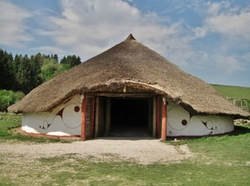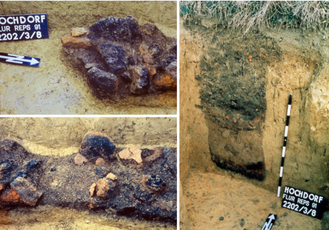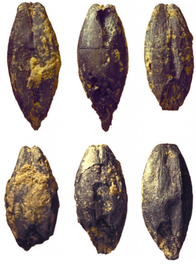Celtic Brewing Practices Around 450 BC in Southern Germany, someone (probably an intern) burnt a special structure. Some thousand years later, a team of archaeologists uncovered this ditch, revealing a well-preserved Iron Age malting facility and a mass amount of germinated barley grain. To figure out just how Iron Age man was malting, Dr. Hans-Peter Stika set up a few experiments to see if he could replicate these grains found at this archaeological site. Site Description Photo of the ditch excavation, with barley at the bottom [1] Photo of the ditch excavation, with barley at the bottom [1] This malting facility is located in Eberdingen-Hochdorf, next to Stuttgart. The area was identified as a farm within the rural residence of a nearby fortified hill top, known as ‘Hohen Asperg.’ There was also a rich grave mound found located just half a kilometer to the east of the site. Given the other finds at the site (such as some fine ceramics and bronze material), it is assumed this farm belonged to a Celtic Prince, probably living at the Hohen Asperg hilltop fort. Six ditches were found, each approximately 5 - 6 m long, 0.6 m wide and up to 1.1 m deep in a U-shaped profile. Since there was no evidence for erosion, Dr. Stika assumed the walls were supported with wooden boards, despite no such boards being excavated. The site turned up three different groups of grains (assemblages). Two contained mostly hulled barley. Although the exact amount of barley isnt specified, it is said to be within the thousands of ‘multirowed barley’, which I'm assuming is six-row. The remaining assemblage had only around 266 individual grains and contained a few other species (wheat varieties and wild plants). Experiment Recovered barley from Hochdorf trenches [1] Recovered barley from Hochdorf trenches [1] So to start the experiment, hulled and naked barley grains were germinated. This was done by soaking both grain types overnight, and then divided into three different groups. These were then exposed to different temperatures, light, and climate:
After the germination process, these subgroups were then compared to modern malts. The best results were under dark and cool conditions with constantly high humidity. Signs of germination began after five days. These experimental grains were then exposed to charring, to make them suitable for comparison to the Hochdorf trench grains. Charring was done at two different temperatures: 250 °C and 350 °C. Grains which were still moist puffed up, whereas dry grains remained morphologically intact. As expected, sprouts from the germination process did not survive, and no sprouts were recovered at the archaeological site. Interestingly, grains which were left to germinate for seven days or longer did not preserve well. ConclusionsSo, in order to replicate the grains found at the Hochdorf site, barley grain had to dry, be evenly sprouted, and only in a slightly sprouted state. Thus, the authors conclude, that this was most likely a malting facility on a large scale. It is tough to say exactly how malting would have been carried out, but at least we can say that Iron Age man was able to produce a consistent and successful malt. Even when compared to modern standards. To explain how this structure was destroyed (and thus ‘placed into’ the archaeological record), the following was proposed: a wooden support holding the dry malt accidently caught on fire, eventually collapsed thus scattering the grains over the bottom of the ditch where they were then covered by said wooden frame. In theory, the ditches could have also been used to dry green malt as well as for germination. Soaked barley grains could easily be spread onto mats (made out of a woven material), and laid on the ditch floor. Then simply cover the top and a damp, cool environment would be created, providing optimal conditions to produce quality malt. These could also be also used for drying the barley, if a small fire at one end of the ditch were started, and other infrastructure installed to create the necessary airflow to successfully dry the grain. But such objects were not found. So what does this all mean? It seems to suggest that Iron Age maltsters knew what they were doing in order to create evenly germinated grain (presumably) for brewing. All there is to do now is to replicate these ditch frames and make some malt. ReferencesStika, Hans-Peter. "Early Iron Age and Late Mediaeval malt finds from Germany—attempts at reconstruction of early Celtic brewing and the taste of Celtic beer." Archaeological and Anthropological Sciences 3.1 (2011): 41-48.
0 Comments
|
Jordan RexBeer archaeologist Archives
November 2017
Categories
All
|
 RSS Feed
RSS Feed
